Return to Complete Index Page
Return to Daily Briefing Page
Folks tell me my web-site
as become a sort of "On-Line Magazine" for handmade
Airguns.
I'm glad you are enjoying
it. In that Spirit, following is an article called . . .
The Accurate Bullet
If you have a decent
rifle, and buy decent bullets for it, you should get good accuracy
. . . correct? Not always.
Let's talk about Bullet Design
The design and fit of those bullets
is critical to the accuracy equation. You must understand the
differences between slug designs to know how they may perform.
I'm forever testing new designs. It's
alot of investment. I must manufacture a tool steel cutter to
machine the cavity of a casting mold. I must then make the bullet
casting mold itself. It's a vast amount of work to make a multi-fluted
bullet shaped machine tool bit and then heat treat it properly.
It's also a good bit of work to make a mold using that cutter.
Then, I have to cast the mold, clean the slugs, and size them
for the particular test rifle. The very first group I shoot might
prove that the design is "wild". At that point, all
of the above work would just become an expensive lesson.
Why bother? Why not just buy a box
of slugs? Because, box bullets are designed first and foremost;
to satisfy the general public, fit into the most rifles and pistols,
and cause reloaders the least trouble. They are the "One
Size Fits All" Suit. As with things of this nature - they
satisfy the tastes of some and not others. If you want to look
well dressed - you need personal attention.
Let's take a look . . .
 This is a small photo of poor quality
but it makes the point I wish to show you. I spent the day at
the range yesterday. For later tests, I covered up the earlier
holes. But; the white dots cover three holes (a group) shot with
a new test slug design @ 50 yards. Not too impressive! That was
alot of work for nothing. That's a nice tight 6" group @50
yards! Ha ha. Those pretty slugs flew properly oriented and punched
nice clean holes - they just would not group. Lesson #1.
This is a small photo of poor quality
but it makes the point I wish to show you. I spent the day at
the range yesterday. For later tests, I covered up the earlier
holes. But; the white dots cover three holes (a group) shot with
a new test slug design @ 50 yards. Not too impressive! That was
alot of work for nothing. That's a nice tight 6" group @50
yards! Ha ha. Those pretty slugs flew properly oriented and punched
nice clean holes - they just would not group. Lesson #1.
 See any difference? This #26 Test Slug
grouped into a cloverleaf @ 50 yards. Same identical set-up as
above. Shot back to back. This one has promise! lesson #2.
OK, here's a test . . . Are you ready?
See any difference? This #26 Test Slug
grouped into a cloverleaf @ 50 yards. Same identical set-up as
above. Shot back to back. This one has promise! lesson #2.
OK, here's a test . . . Are you ready?
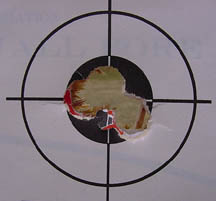 _
_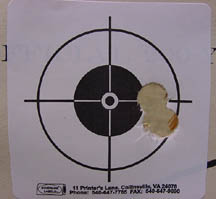 Both are 25 Yard 3 shot groups. Placement
was different because I was "Holding Off" with a 75
yard scope setting.
Still - "groups are groups."
Is this an "Accurate Bullet? It looks pretty good so far
I'd say! Look at that group on the right - 3 slugs 45 caliber
went through there.
AHhhh!, Now we learn something . .
.
First, let's cover this issue of "Holding
Off" - everyone might not understand that. Where you aim
your sights, might not always be where the bullet strikes. If
your gun, bullet, and sights are each accurate, but they are not
"coordinated", your POA (Point of Aim) and your POI
(Point of Impact) will not be together. You could shoot your rifle
like this if you wanted. If you knew it shot four inches to the
right and eight inches high, you could actually aim four inches
left and eight inches low, and still hit your target every time.
Sounds silly, for sure, but it's true. Why would anyone do this?
Let's see.
If you are testing unknown slugs at
multiple distances, you'd drive yourself nuts adjusting the scope
to get things right. You would never know if the scope was set
wrong or if the bullet was no good. You must take as many varibles
out of the equation as possible. So; you set your scope for a
known slug, at a known distance, and you let it alone. Done. That
becomes your "Control". Don't touch it again!
Now. We pick one "Control POA".
We always aim at that exact spot. We begin to shoot the unknown
test slugs. We see that different designs and weights will group
in different locations. In a perfect world, we'd see the heavier
ones grouped alittle lower than the lighter ones. They'd all be
in a nice vertical line depending upon the distance to the target.
Wouldn't that be nice? Don't get used to it . . . It rarely happens.
When we look at our groups, we will
note; A). Some have done just that - placed in a nice vertical
location. B). Others grouped well but in an odd location (right
or left). and C). Still others have completely gone "Walkabout"
- the shotgun pattern..
Based upon the above, let's look at
this most wonderful chart . . .
Both are 25 Yard 3 shot groups. Placement
was different because I was "Holding Off" with a 75
yard scope setting.
Still - "groups are groups."
Is this an "Accurate Bullet? It looks pretty good so far
I'd say! Look at that group on the right - 3 slugs 45 caliber
went through there.
AHhhh!, Now we learn something . .
.
First, let's cover this issue of "Holding
Off" - everyone might not understand that. Where you aim
your sights, might not always be where the bullet strikes. If
your gun, bullet, and sights are each accurate, but they are not
"coordinated", your POA (Point of Aim) and your POI
(Point of Impact) will not be together. You could shoot your rifle
like this if you wanted. If you knew it shot four inches to the
right and eight inches high, you could actually aim four inches
left and eight inches low, and still hit your target every time.
Sounds silly, for sure, but it's true. Why would anyone do this?
Let's see.
If you are testing unknown slugs at
multiple distances, you'd drive yourself nuts adjusting the scope
to get things right. You would never know if the scope was set
wrong or if the bullet was no good. You must take as many varibles
out of the equation as possible. So; you set your scope for a
known slug, at a known distance, and you let it alone. Done. That
becomes your "Control". Don't touch it again!
Now. We pick one "Control POA".
We always aim at that exact spot. We begin to shoot the unknown
test slugs. We see that different designs and weights will group
in different locations. In a perfect world, we'd see the heavier
ones grouped alittle lower than the lighter ones. They'd all be
in a nice vertical line depending upon the distance to the target.
Wouldn't that be nice? Don't get used to it . . . It rarely happens.
When we look at our groups, we will
note; A). Some have done just that - placed in a nice vertical
location. B). Others grouped well but in an odd location (right
or left). and C). Still others have completely gone "Walkabout"
- the shotgun pattern..
Based upon the above, let's look at
this most wonderful chart . . .
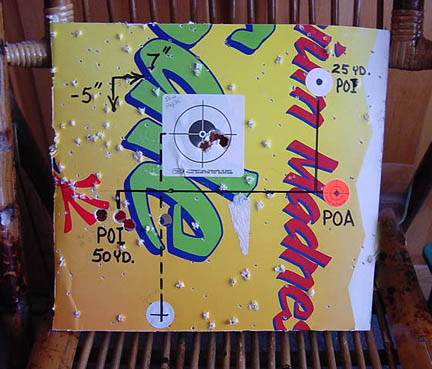 Lovely . . .
Yes, it was a piece of colorful rubbish
I pressed into service at the range.
Now, you remember those beautiful 25
yard cloverleaves posted above? Well, remember I said I was using
a 75 yard scope setting for a control slug. Actually - even that
was grouping an inch or so right - I just never changed it. Now,
when I shot those 25 yard groups, I needed to aim low (75 yard
setting - shooting 25 yards - less drop). If you'd super-impose
those 25 yard targets onto this chart, you'd see that I aimed
at the orange POA and hit about 4" above it.
So; the location of the upper 25 Yard
POI is shown on the chart (as computed from the 25 yard backer
where I shot those targets). I was very pleased. I decided to
see if these test slugs would fly well to 50 yards. I pressed
this old shotgun riddled foam board into service. Please note
the location of the lower left POI group (I still got a pretty
good 50 yard group). But, look at the placement! It's five inches
lower than the 25 yard placement. That's not good. But; what really
seals it's doom is that it's seven inches left!
Bottom line?: This slug is very consistent.
The rifle is amazingly consistent in shooting this slug each time.
BUT - this test slug is a "Curve Ball". It does, what
it does, the same each time. BUT; it's trajectory is unusable
because it flies in a left hand compound arc (away from the muzzle
and down). Nice clean holes. Consistent grouping. BUT - a "Curve
Ball" all the same. It's of no use. Expensive lesson learned
#3.
Lovely . . .
Yes, it was a piece of colorful rubbish
I pressed into service at the range.
Now, you remember those beautiful 25
yard cloverleaves posted above? Well, remember I said I was using
a 75 yard scope setting for a control slug. Actually - even that
was grouping an inch or so right - I just never changed it. Now,
when I shot those 25 yard groups, I needed to aim low (75 yard
setting - shooting 25 yards - less drop). If you'd super-impose
those 25 yard targets onto this chart, you'd see that I aimed
at the orange POA and hit about 4" above it.
So; the location of the upper 25 Yard
POI is shown on the chart (as computed from the 25 yard backer
where I shot those targets). I was very pleased. I decided to
see if these test slugs would fly well to 50 yards. I pressed
this old shotgun riddled foam board into service. Please note
the location of the lower left POI group (I still got a pretty
good 50 yard group). But, look at the placement! It's five inches
lower than the 25 yard placement. That's not good. But; what really
seals it's doom is that it's seven inches left!
Bottom line?: This slug is very consistent.
The rifle is amazingly consistent in shooting this slug each time.
BUT - this test slug is a "Curve Ball". It does, what
it does, the same each time. BUT; it's trajectory is unusable
because it flies in a left hand compound arc (away from the muzzle
and down). Nice clean holes. Consistent grouping. BUT - a "Curve
Ball" all the same. It's of no use. Expensive lesson learned
#3.
 Here's a closeup of the target in the
center of the chart. Here's my "Control Group" for this
new slug test. That's a 50 yard three shot group with my Barnes
45 caliber Raptor Slugs. I know they are a winner.
Here's a closeup of the target in the
center of the chart. Here's my "Control Group" for this
new slug test. That's a 50 yard three shot group with my Barnes
45 caliber Raptor Slugs. I know they are a winner.
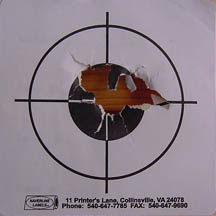 Here's the control 25 yard group I
shot with these Raptors. It's a fine tight, centered, 3 shot cloverleaf.
I used a slightly left 6 o'clock hold for the scope setting I
was using (remember that setting was grouping alittle right anyway
- so a slightly left 6 o'clock was an appropriate correction).
Looking at the chart, you can see that
my 50 yd. POA for the Raptors was also approx 6 o'clock left.
This shows the vast
difference between slugs. While each
slug groups well @ 25 and 50 yards: the Raptors "Stack".
They shoot in a vertical plane. That makes all the difference
in the world.
Let's talk about Slug Grading
You can't expect different things to
behave the same. If your slugs are of different weights, they
are different. If some are all beat up and others not - they are
different. If they are of varying diameters, they are different.
Think of it this way . . . it's like a quiver full of different
arrows. Some have a feather off. Some are heavier than others.
Some have the nock broken. Some are taped up. Etc. (That's the
way we shot as kids - we had to compensate for each arrow we owned
as we collected them over years and never retired one if we could
help it).
Well, we're not kids anymore. if we
want real accuracy, we need consistent ammo that fits our rifle.
Let's look at the difference.
Here's the control 25 yard group I
shot with these Raptors. It's a fine tight, centered, 3 shot cloverleaf.
I used a slightly left 6 o'clock hold for the scope setting I
was using (remember that setting was grouping alittle right anyway
- so a slightly left 6 o'clock was an appropriate correction).
Looking at the chart, you can see that
my 50 yd. POA for the Raptors was also approx 6 o'clock left.
This shows the vast
difference between slugs. While each
slug groups well @ 25 and 50 yards: the Raptors "Stack".
They shoot in a vertical plane. That makes all the difference
in the world.
Let's talk about Slug Grading
You can't expect different things to
behave the same. If your slugs are of different weights, they
are different. If some are all beat up and others not - they are
different. If they are of varying diameters, they are different.
Think of it this way . . . it's like a quiver full of different
arrows. Some have a feather off. Some are heavier than others.
Some have the nock broken. Some are taped up. Etc. (That's the
way we shot as kids - we had to compensate for each arrow we owned
as we collected them over years and never retired one if we could
help it).
Well, we're not kids anymore. if we
want real accuracy, we need consistent ammo that fits our rifle.
Let's look at the difference.
 This shows me that my #26 slug, that
tested so well @ 50 yards, is still doing duty @ 75 yards.
This shows me that my #26 slug, that
tested so well @ 50 yards, is still doing duty @ 75 yards.


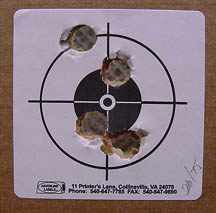 Take a look. I shot these three groups
back to back @ 75 yards.
When testing new slugs, it's alot of
work to get everything ready and then cast a selection of each
new type. There's no point going to the range with just a hand
full of each. If I find a good design, I'll need to shoot many
groups. By the same token, if I find the first group sprays all
over the target, then I have a bunch of wasted work in that test
batch. That's also why I can't go to the range with just one new
batch. After a big set-up, I might be done in ten minutes if the
slug won't fly. Because of this, I test several new designs at
a time.
I cast and I size but I don't go to
extremes grading each test lot. I already had seven different
containers of slugs yesterday. If I'd have graded them too, I'd
have had at least 14 containers and taken alot more time getting
ready. It's best to just see if they "Want" to fly before
investing alot of time in trophy slugs that might be a bust.
I said all of that to explain why I
was shooting slugs of mixed grades yesterday. Now, please look
at three targets posted immediately above. These were shot back
to back to back @ 75 yards. The top one has a "double"
at approx. 9 o'clock in the bull. The second one also has a 9
o'clock in the bull. The third has another 9 o'clock in the bull
and a couple of more tightly by. That's no accident. I also didn't
completely loose it when I shot those flyers. They were evidently
#2 slugs.
So, at the end of a week's work, I
have a new slug. #26 will go into the books.
Hope you enjoyed coming along and I
hope you may have learned something.
Remember, Barnes customers may buy
custom Barnes Bullet molds and Our "Black Tie Casting Service"
will cast and size them for you.
Take a look. I shot these three groups
back to back @ 75 yards.
When testing new slugs, it's alot of
work to get everything ready and then cast a selection of each
new type. There's no point going to the range with just a hand
full of each. If I find a good design, I'll need to shoot many
groups. By the same token, if I find the first group sprays all
over the target, then I have a bunch of wasted work in that test
batch. That's also why I can't go to the range with just one new
batch. After a big set-up, I might be done in ten minutes if the
slug won't fly. Because of this, I test several new designs at
a time.
I cast and I size but I don't go to
extremes grading each test lot. I already had seven different
containers of slugs yesterday. If I'd have graded them too, I'd
have had at least 14 containers and taken alot more time getting
ready. It's best to just see if they "Want" to fly before
investing alot of time in trophy slugs that might be a bust.
I said all of that to explain why I
was shooting slugs of mixed grades yesterday. Now, please look
at three targets posted immediately above. These were shot back
to back to back @ 75 yards. The top one has a "double"
at approx. 9 o'clock in the bull. The second one also has a 9
o'clock in the bull. The third has another 9 o'clock in the bull
and a couple of more tightly by. That's no accident. I also didn't
completely loose it when I shot those flyers. They were evidently
#2 slugs.
So, at the end of a week's work, I
have a new slug. #26 will go into the books.
Hope you enjoyed coming along and I
hope you may have learned something.
Remember, Barnes customers may buy
custom Barnes Bullet molds and Our "Black Tie Casting Service"
will cast and size them for you.



 _
_






